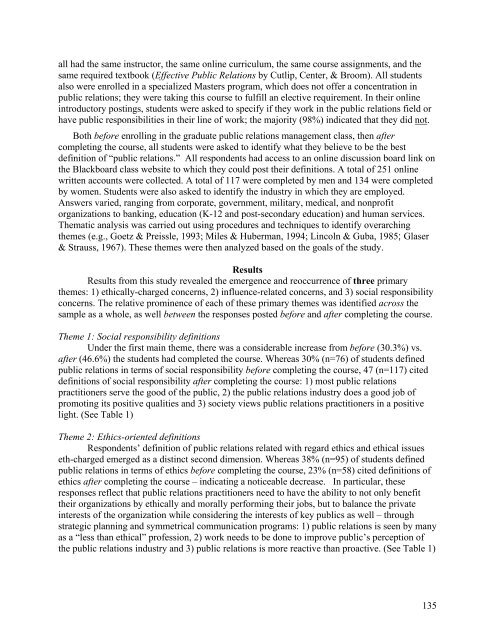2008 PROCEEDINGS - Public Relations Society of America
2008 PROCEEDINGS - Public Relations Society of America
2008 PROCEEDINGS - Public Relations Society of America
Create successful ePaper yourself
Turn your PDF publications into a flip-book with our unique Google optimized e-Paper software.
all had the same instructor, the same online curriculum, the same course assignments, and the<br />
same required textbook (Effective <strong>Public</strong> <strong>Relations</strong> by Cutlip, Center, & Broom). All students<br />
also were enrolled in a specialized Masters program, which does not <strong>of</strong>fer a concentration in<br />
public relations; they were taking this course to fulfill an elective requirement. In their online<br />
introductory postings, students were asked to specify if they work in the public relations field or<br />
have public responsibilities in their line <strong>of</strong> work; the majority (98%) indicated that they did not.<br />
Both before enrolling in the graduate public relations management class, then after<br />
completing the course, all students were asked to identify what they believe to be the best<br />
definition <strong>of</strong> “public relations.” All respondents had access to an online discussion board link on<br />
the Blackboard class website to which they could post their definitions. A total <strong>of</strong> 251 online<br />
written accounts were collected. A total <strong>of</strong> 117 were completed by men and 134 were completed<br />
by women. Students were also asked to identify the industry in which they are employed.<br />
Answers varied, ranging from corporate, government, military, medical, and nonpr<strong>of</strong>it<br />
organizations to banking, education (K-12 and post-secondary education) and human services.<br />
Thematic analysis was carried out using procedures and techniques to identify overarching<br />
themes (e.g., Goetz & Preissle, 1993; Miles & Huberman, 1994; Lincoln & Guba, 1985; Glaser<br />
& Strauss, 1967). These themes were then analyzed based on the goals <strong>of</strong> the study.<br />
Results<br />
Results from this study revealed the emergence and reoccurrence <strong>of</strong> three primary<br />
themes: 1) ethically-charged concerns, 2) influence-related concerns, and 3) social responsibility<br />
concerns. The relative prominence <strong>of</strong> each <strong>of</strong> these primary themes was identified across the<br />
sample as a whole, as well between the responses posted before and after completing the course.<br />
Theme 1: Social responsibility definitions<br />
Under the first main theme, there was a considerable increase from before (30.3%) vs.<br />
after (46.6%) the students had completed the course. Whereas 30% (n=76) <strong>of</strong> students defined<br />
public relations in terms <strong>of</strong> social responsibility before completing the course, 47 (n=117) cited<br />
definitions <strong>of</strong> social responsibility after completing the course: 1) most public relations<br />
practitioners serve the good <strong>of</strong> the public, 2) the public relations industry does a good job <strong>of</strong><br />
promoting its positive qualities and 3) society views public relations practitioners in a positive<br />
light. (See Table 1)<br />
Theme 2: Ethics-oriented definitions<br />
Respondents’ definition <strong>of</strong> public relations related with regard ethics and ethical issues<br />
eth-charged emerged as a distinct second dimension. Whereas 38% (n=95) <strong>of</strong> students defined<br />
public relations in terms <strong>of</strong> ethics before completing the course, 23% (n=58) cited definitions <strong>of</strong><br />
ethics after completing the course – indicating a noticeable decrease. In particular, these<br />
responses reflect that public relations practitioners need to have the ability to not only benefit<br />
their organizations by ethically and morally performing their jobs, but to balance the private<br />
interests <strong>of</strong> the organization while considering the interests <strong>of</strong> key publics as well – through<br />
strategic planning and symmetrical communication programs: 1) public relations is seen by many<br />
as a “less than ethical” pr<strong>of</strong>ession, 2) work needs to be done to improve public’s perception <strong>of</strong><br />
the public relations industry and 3) public relations is more reactive than proactive. (See Table 1)<br />
135
















